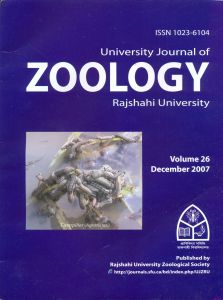Efficacy of edible oils in the control of pulse beetle, <i>Callosobruchus chinensis</i> L. in stored pigeonpea
DOI:
https://doi.org/10.3329/ujzru.v26i0.707Keywords:
Vegetable oils, Callosobruchus, pigeonpea, progeny emergence, grain protectantAbstract
Seven vegetable oils viz., sunflower (Heliunthus annus, L.), mustard (Brassica juncea Cross ), groundnut (Arachis hypogaea, L.), sesame (Sesamum indicum L.), soybean [Glycine max L. (Merril)], olive (Olea europea) and oil palm (Elaeis guineensis W. J. Jacquin), each were applied at the rates of 5, 7.5, and 10 ml.kg-1 of grain (0.5, 0.75 and 1% v/w concentrations) as grain protectants of pigeonpea against the pulse beetles (Callosobruchus chinensis L.). Effects on progeny emergence, loss in grain weight, and germination up to 66 days after treatment were measured. Adult emergence was completely prevented and the minimum grain loss was achieved by groundnut oil at 1% up to 66 days after treatment. Since treatments with groundnut and palm oils at 5 ml.kg-1 showed high acceptability by consumers, it can be recommended for C. chinensis control in stored pigeonpea for approximately two months. Key Words: Vegetable oils, Callosobruchus, pigeonpea, progeny emergence, grain protectant Univ. j. zool. Rajshahi Univ. Vol. 26, 2007. pp. 89-92Downloads
Download data is not yet available.
Abstract
389
389
PDF
567
567
Downloads
How to Cite
Khalequzzaman, M., Mahdi, S. H. A., & Goni, S. O. (2008). Efficacy of edible oils in the control of pulse beetle, <i>Callosobruchus chinensis</i> L. in stored pigeonpea. University Journal of Zoology, Rajshahi University, 26, 89–92. https://doi.org/10.3329/ujzru.v26i0.707
Issue
Section
Articles

